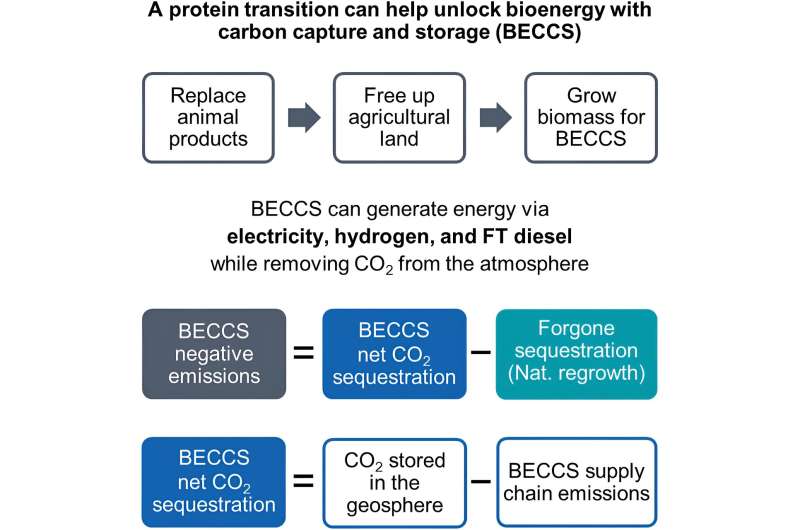This article has been reviewed according to Science X's editorial process and policies. Editors have highlighted the following attributes while ensuring the content's credibility:
fact-checked
peer-reviewed publication
trusted source
proofread
Replacing animal-based foods with alternative proteins would unlock land for carbon removal, say researchers

Researchers report that replacing 50% of animal products with alternative proteins by 2050 could free up enough agricultural land to generate renewable energy equivalent in volume to today's coal-generated power while simultaneously removing substantial CO2 from the atmosphere.
The study, published in the journal One Earth, is based on a CO2-removal method known as "bioenergy with carbon capture and storage" (BECCS), which involves cultivating quickly growing crops whose biomass can then be stored permanently in geological formations or used as a feedstock to produce renewable energy.
Most studies of BECCS assume that the land required to grow this biomass would threaten food security or be attained via agricultural expansion into regions of natural vegetation, which has negative implications for biodiversity, but the researchers of the new study had another idea: to combine BECCS with a dietary shift.
"Animal-source foods use resources inefficiently because animals consume more food than they provide, and feeding the animals requires considerable land and water," write the researchers, led by environmental scientist Oscar Rueda of Leiden University. "We show that a protein transition could free up extensive resources for BECCS to achieve substantial energy and carbon-removal potentials."
To test how a dietary shift might augment carbon removal, the researchers estimated how much land would be freed up if humans replaced 10% to 100% of animal protein with plant-based or other alternative proteins. Then, they estimated the potential for using this land for biomass production while keeping sufficient land and water available to sustain ecosystems and meet global food and water needs.
"Our results show that replacing animal products can help unlock vast energy and negative emission potentials via BECCS while avoiding agricultural expansion and securing water supply for people and ecosystems," the researchers write. "Even modest adoption levels of alternative proteins could free up large agricultural areas."
Their model suggested that even a 30% reduction in animal-product consumption would enable significant carbon removal and renewable energy production. If 30% of animal products were replaced by alternative proteins, it would free up enough area to generate between 15.8 and 29.1 EJelec per year and remove 3.5–7.2 Gt of CO2 per year. (Currently, coal power generates 35 EJelec per year and results in 10 Gt of CO2 emissions.)
The team also analyzed global geographical locations for their potential for biomass production and CO2 storage. They found that most countries have the geological potential to sequester CO2 from BECCS within their borders. In particular, the researchers note that "the US, Europe, and China stand out for their considerable sequestration potential."
They also demonstrated that planting biomass crops for BECCS on freed-up agricultural land would be more effective at carbon removal than natural revegetation. If 100% of animal products were replaced by alternatives, using those areas for BECCS for around 60 years could remove 700 Gt more CO2 than natural revegetation of those same areas.
After that period, the researchers say, the areas could revert to natural vegetation, and the researchers note that BECCS is no replacement for nature.
"On the one hand, BECCS could use a fraction of the freed-up land to boost climate mitigation while producing renewable energy," says Rueda. "On the other hand, natural revegetation could be preferable in many areas, especially those that may be close to their natural state."
The researchers say that a protein transition is feasible, but it's uncertain what this transition would look like and whether it would be dominated by traditional plant-based proteins or lab-based alternatives.
"Market research shows that alternative proteins, from sources such as plants, microorganisms, and tissue culture, could replace 10%–30% of animal products in 2030 and 30%–70% in 2050," the researchers write. "Emerging research on novel alternative proteins can further clarify uncertainties of adoption and impacts."
Since different alternative proteins would have different footprints, further research will need to examine these various scenarios. Examining how sociopolitical factors might impact the proposed dietary shift and the adoption of BECCS will also require further study.
More information: A protein transition can free up land to tap vast energy and negative emission potentials, One Earth (2024). DOI: 10.1016/j.oneear.2023.12.016. www.cell.com/one-earth/fulltex … 2590-3322(23)00600-0
Journal information: One Earth
Provided by Cell Press



















